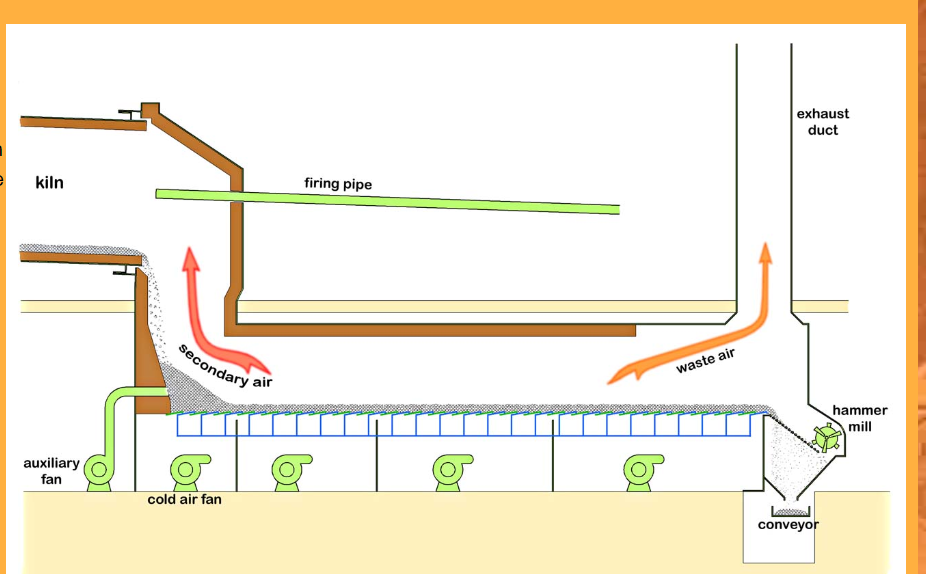Contents
Grate Coolers in the Cement Industry

TO Download this post and all the books and excel sheets and my personal notes and presentations I collected about cement industry in the last 30 years click the below paypal link
Introduction
Grate coolers are vital components in the cement industry, responsible for cooling clinker produced in the kiln. Modern advancements in grate cooler technology have significantly improved their efficiency and durability. This report provides an in-depth look at the most important and modern types of grate coolers, popular brands and models, and detailed maintenance guidelines, including estimated costs and labor hours.
Types of Grate Coolers in the Cement Industry
- Reciprocating Grate Coolers
- Static Grate Coolers
- Planetary Grate Coolers
Reciprocating Grate Coolers
Role: Reciprocating grate coolers are designed to cool the clinker by moving it through a series of grates in a reciprocating motion. This ensures efficient heat exchange and effective cooling.
Popular Brands and Models:
- FLSmidth: Cross-Bar Cooler
- IKN GmbH: Pendulum Cooler
- Thyssenkrupp: Polysius® Reciprocating Grate Cooler
Estimated Price: $500,000 – $1,500,000 depending on capacity and customization.
Static Grate Coolers
Role: Static grate coolers utilize a fixed grate system where the clinker is cooled by a stream of air passing through the grates. This method is less complex and requires lower maintenance.
Popular Brands and Models:
- Claudius Peters: ETA Cooler
- SINOMALY: Grate Cooler
- A TEC: Static Grate Cooler
Estimated Price: $300,000 – $1,000,000.
Planetary Grate Coolers
Role: Planetary grate coolers feature rotating planetary gears that spread the clinker uniformly over the grate, ensuring efficient cooling and heat recovery.
Popular Brands and Models:
- Fons Technology: Planetary Grate Cooler
- Fives Group: Planetary Cooler
- FL Smidth: SF Cross-Bar Cooler
Estimated Price: $400,000 – $1,200,000.
Modern Types of Grate Coolers
- Advanced Modular Coolers: Modular designs allow for easy installation and maintenance, featuring replaceable modules that enhance cooling efficiency.
- High-Efficiency Coolers: These incorporate advanced heat exchange technologies, such as air-to-air heat exchangers, to improve thermal efficiency.
- Low-Pressure Drop Coolers: Designed to reduce pressure drop across the cooler, improving airflow and energy efficiency.
Maintenance Guidelines for Grate Coolers
Predictive Maintenance
Predictive Maintenance Tools:
- Vibration Analysis: Monitors vibrations to detect misalignments or bearing failures.
- Thermal Imaging: Identifies hotspots indicating potential issues in the cooler.
- Acoustic Monitoring: Detects unusual noises that may signify mechanical problems.
Estimated Cost:
- Vibration Analysis Equipment: $10,000 – $20,000
- Thermal Imaging Cameras: $5,000 – $15,000
- Acoustic Monitoring Tools: $5,000 – $10,000
Labor Hours:
- Setup and Monitoring: 8-16 hours monthly.
Preventive Maintenance
Tasks:
- Regular Inspections: Visual and mechanical inspections to identify wear and tear.
- Lubrication: Ensuring all moving parts are well-lubricated to prevent friction and wear.
- Component Replacement: Proactive replacement of wear parts like grates and seals.
Estimated Cost:
- Lubricants: $500 – $1,000 annually
- Replacement Parts: $20,000 – $50,000 annually
Labor Hours:
- Inspections: 24-40 hours monthly
- Lubrication and Minor Repairs: 16-32 hours monthly
- Component Replacement: 100-200 hours annually
Periodic Maintenance
Tasks:
- Thorough Cleaning: Removing clinker dust and debris from the cooler.
- Alignment Checks: Ensuring proper alignment of moving parts.
- Detailed Inspections: In-depth checks of all mechanical and structural components.
Estimated Cost:
- Cleaning Equipment: $2,000 – $5,000 annually
- Alignment Tools: $1,000 – $2,000 annually
- Inspection Costs: $5,000 – $10,000 annually
Labor Hours:
- Cleaning: 80-120 hours annually
- Alignment and Inspection: 60-100 hours annually
Conclusion
Grate coolers are essential for the efficient operation of cement plants, ensuring that clinker is cooled effectively and efficiently. The choice of grate cooler depends on the specific requirements of the cement plant, including capacity, maintenance needs, and energy efficiency goals. Predictive and preventive maintenance are crucial for maximizing the lifespan and performance of grate coolers, with modern technologies offering new ways to monitor and maintain these critical components. Proper maintenance practices not only ensure operational efficiency but also contribute to cost savings and reliability in cement production.
References
- FLSmidth: Cross-Bar Cooler
- IKN GmbH: Pendulum Cooler
- Thyssenkrupp: Polysius® Reciprocating Grate Cooler
- Claudius Peters: ETA Cooler
- SINOMALY: Grate Cooler
- A TEC: Static Grate Cooler
- Fons Technology: Planetary Grate Cooler
- Fives Group: Planetary Cooler
- FL Smidth: SF Cross-Bar Cooler
